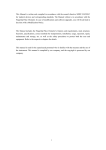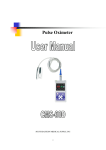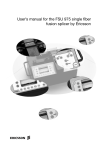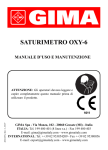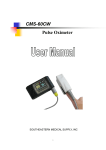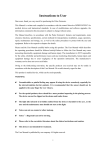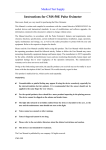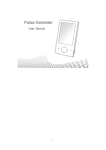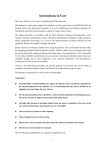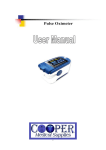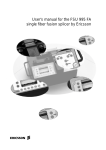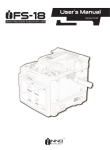Download This Manual is written and compiled in accordance with the council
Transcript
Pulse Oximeter SOUTHEASTERN MEDICAL SUPPLY, INC I This Manual is written and complied in accordance with the council directive MDD 93/42/EEC for medical devices and corresponding standards. This Manual is written in accordance with standards for the Fingertip Pulse Oximeter. In case of modifications and software upgrades, you will be advised in due time with a Modification Notice. The Manual includes the Fingertip Pulse Oximeter’s features, main structure, functions, specifications, correct methods for transportation, installation, usage, operation, repair, maintenance and storage, etc. as well as the safety procedures to protect both the user and equipment. Refer to the respective chapters for details. This manual is designed to be used by experienced personnel who are familiar with the measurements of blood oxygen saturation and the use of this type of instrument. This manual is compiled by our company in cooperation with Southeastern Medical Supply, Inc. and the copyright is possessed by our company. II Instructions to User Dear Users, thank you very much for purchasing The CMS 50-E Fingertip Pulse Oximeter. Please read these instructions carefully before using this equipment. These instructions describing the operating procedures should be followed strictly. Failure to follow these instructions can cause measuring abnormality, equipment damage and personal injury. The manufacturer is NOT responsible for the safety, reliability and performance issues and any monitoring abnormality, personal injury and equipment damage due to user’s negligence of the operation instructions. The manufacturer’s warranty service does not cover such faults. This product is a medical device, and can be used repeatedly. Its assumed useful life is 3 years. III WARNING: 0 For the special patients with pulmonary disorders such as COPD and other respiratory and circulatory problems, more prudent placing of the device must be used. The device can not be clipped on any edema or tender tissue. 0 The red laser light (the infrared is invisible) emitted from the device is harmful to the eyes, so do not stare at the light or shine it into anyone’s eyes. 0 Testee can not use heavy thick enamel or acrylic fake fingernails. 0 Testee’s fingernail can not be too long as to prohibit the proper placement of the finger into the device. 0 Please refer to the correlative literature about the clinical restrictions and caution. 0 This device is not intended for treatment. Please consult your physician prior to use. Pulse Oximeter Proper Use Tips: PLACE FINGER INSIDE UNIT BEFORE TURNING ON SLIDE FINGER TO BACK OF UNIT AND VERIFY SENSOR IS UNDER FINGER PAD TURN DEVICE ON AND VERIFY SIGNAL QUALITY WITH PLETHYSMOGRAPH BAR WAVEFORM AND/OR PULSE SIGNAL STRENGTH BAR. Please Note: Turning the device on before finger is properly positioned will cause erratic readings and affect the operation of the device A flexible circuit wire connects the two parts of the device. Do not twist or pull on the connection. Attaching the Lanyard Cord to this wire will damage the device and is not covered under warranty. USE THE LANYARD PORT HOLES ON THE END OF THE DEVICE TO ATTACH THE LANYARD CORD. IV Table of Contents 1. SAFETY .............................................................................................................................................1 1.1. INSTRUCTIONS FOR SAFE OPERATION ......................................................................................1 1.2. WARNINGS ..............................................................................................................................1 1.3. HAZARDS ................................................................................................................................1 2. OVERVIEW ......................................................................................................................................2 2.1. FEATURES ...............................................................................................................................2 2.2. DESIGNED DEVICE APPLICATION ............................................................................................2 2.3. ENVIRONMENTAL REQUIREMENTS ..........................................................................................2 3. PRINCIPLE AND CAUTION ...........................................................................................................3 3.1. PRINCIPLE OF SPO2 MEASUREMENT.......................................................................................3 3.2. PRIOR TO OPERATION .............................................................................................................3 3.3. CLINICAL RESTRICTIONS.........................................................................................................4 4. TECHNICAL SPECIFICATIONS ...................................................................................................4 5. ACCESSORIES ................................................................................................................................5 6. INSTALLATION ..............................................................................................................................5 6.1. VIEW OF THE FRONT PANEL .....................................................................................................5 6.2. MOUNTING OF THE LANYARD CORD ..................................................................................6 7. OPERATING GUIDE ......................................................................................................................6 8. CLEANING AND DISINFECTING ...............................................................................................10 9. REPAIRING AND MAINTENANCE.............................................................................................10 10. TROUBLESHOOTING................................................................................................................. 11 11. KEY OF SYMBOLS....................................................................................................................... 11 12. FUNCTIONAL SPECIFICATIONS.............................................................................................12 V 1. Safety 1.1 Instructions for safe operation ◇ Check the main unit and all accessories periodically to make sure that there is no visible damage that may affect patient’s safety and monitoring performance. It is recommended that the device should be inspected at least once a week. Please stop using the monitor if there is obvious damage to the device. ◇ Necessary maintenance must be performed by qualified service engineers ONLY. There are no user serviceable parts and users are not permitted to service the device by themselves. ◇ The oximeter cannot be used together with devices not specified in User’s Manual. Please use the device as recommended by the Manufacturer. 1.2 Warnings 0 Explosive hazard—DO NOT use the oximeter in environment with flammable gas such as some ignitable anesthetic agents. 0 DO NOT use the oximeter while the testee is under measurement of an MRI or CT. 0 Be careful with the use of the lanyard cord. Improper use of the lanyard cord will cause device damage not covered under the manufacturer’s warranty. Swinging the device by the lanyard cord will void the warranty. Please do not use lanyard cord if allergic to lanyard cord. 0 Please do not use this product if allergic to rubber latex finger cushion cushion. 0 Please dispose of the device, accessories and packing materials (including plastic bag, foam and carton) according to local laws. 1.3 Hazards Keep the oximeter away from dust, vibration, corrosive substances, explosive materials, high temperature and moisture. If the oximeter gets wet, please stop using it immediately. When it is carried from cold environment to warm and humid environment, please do not use it as condensation formed by use could cause damage to the device. Allow the device to resume room temperature before use. DO NOT operate button on front panel with any sharp objects. High temperature or high pressure steam disinfection of the oximeter is not permitted. Refer to User’s Manual for instructions of cleaning and disinfection. Do not immerse the oximeter in liquid. When it needs cleaning, please wipe its surface with disinfectant solution using a soft cloth. Do not spray any liquid directly onto the device. When cleaning the device with water, the temperature should be less than 60℃ (140oF). 1 2. Overview The pulse oxygen saturation is the percentage of HbO2 in the total Hb in the blood, called the O2 concentration in the blood. It is an important bio-parameter for the respiration. For the purpose of measuring the SpO2 more easily and accurately, our company developed the CMS50-E Fingertip Pulse Oximeter. The device can also measure the pulse rate simultaneously. The CMS50-E Fingertip Pulse Oximeter is small, with low power consumption, convenient to use and carry. You just need to place the fingertip into the sensor of the device, the SpO2 value will appear on the screen immediately. In the clinical practice, the accuracy tolerance is ±2% in the measurement range from 70% to 100%. 2.1. Features D. E. The device can accurately measure SpO2 and pulse rate. The device will power off automatically if no signal is detected within 5 seconds. A rechargeable lithium battery is required for operation with a continuous operating time of 12 hours. When Low-Voltage Warning is displayed on screen, the device needs to be recharged. Light and portable with a total weight of about 50g with battery. F. Classification: Class II a, (MDD93/42/EEC G. H. The device has the function of USB transmission to a PC. The device can store patient’s data in memory and has adjustable alarm functions. A. B. C. IX Rule 10 2.2. Designed Device application The CMS50-E Fingertip Pulse Oximeter can detect SpO2 and pulse rate through the patient’s finger and indicate the pulse intensity by the bar-display and strength of signal with a plethysmograph display. This device is applicable for use in home, hospitals (surgery, anesthesiology department, department of pediatrics, emergency room), oxygen bar, the community medical center, physical therapy in sports (you can use the device before or after the sport, but it is not recommended to use it during the sport) and so on. 2.3. Environmental requirements Transport and storage a)Temperature: -20°C~55°C (-4oF~131 oF) b)Humidity: ≤95% c)Pressure: 500hPa~1060hPa Operating a)Temperature: 10°C ~40°C (10oF~104 oF) b)Humidity: 35%~75% c)Pressure: 700hPa~1060hPa 2 3. Principle and Caution 3.1. Principle of SPO2 measurement The measurement of the pulse oximeter is made by using a multi-functional oxyhemoglobinometer to transmit some narrow spectrum light bands through blood samples, and to measure attenuation of spectrum with different wavelengths according to the characteristic that RHb, O2Hb, Met Hb and COHb absorb the light of different wavelength, thereby determining O2Hb saturation of different fractions. O2Hb saturation is called “fractional” O2Hb saturation. Fractional O2Hb saturation = [O2Hb / (RHb + O2Hb + Met Hb + COHb) x 100 Oppositely, pulse oxygen oximeter measures functional O2Hb saturation: Functional O2Hb saturation = [O2Hb / (RHb + O2Hb)] x 100 Present SpO2 oximeters transmit light of two wavelengths only, red light (wavelength 660 nm) and infrared (wavelength 940nm), to differentiate HbO2 from HbR. One side of the sensor contains two LEDs, and the other side contains a photoelectric detector. SpO2 oximeter measures HbO2 saturation in the blood by the light plethysmograph when the pulse beats. The result is quite precise when HbO2 saturation is in the range of 70 % ~ 100%. Figure 1. Proper Operating Finger Placement 3.2. Prior to Operation A. The finger should be placed properly (see Figure 1) BEFORE TURNING DEVICE ON or else it may cause inaccurate measurement or delay in readings being displayed. B. The SpO2 sensor and photoelectric receiving tube should be arranged with the fingertip as shown in Figure 1. C. The SpO2 sensor should not be used at a location or on a limb tied with arterial canal or wrapped with a blood pressure cuff or receiving intravenous fluids. D. Make sure the optical path is free from any obstacles like rubber finger sleeve, otherwise it may result in venous pulsation and inaccurate measure of SpO2. E. Excessive ambient light may affect the measuring result. It includes fluorescent lamp, dual ruby light, infrared heater, direct sunlight and etc. Strenuous action of the testee or extreme electrosurgical interference may also affect the accuracy. Device is not designed for use while testee is in motion. F. Please clean and disinfect the device after operating according to the user manual. 3 3.3. Clinical restrictions A. As the measurement is taken on the basis of arteriole pulse, substantial pulsating blood flow of the testee is required. For a testee with weak pulse due pulmonary disorders such as COPD, shock, low ambient/body temperature, major bleeding or use of vascular contracting drugs, the SpO2 waveform (PLETH) will decrease. In this case, the measurement will be more sensitive to interference and inaccuracies. B. For those with a substantial amount of staining dilution drug (such as methylene blue, indigo green and acid indigo blue), carbon monoxide hemoglobin (COHb), methionine (Me+Hb) thiosalicylic hemoglobin, and some with icterus problem, the SpO2 determination by this device may be inaccurate. C. Drugs like dopamine, procaine, prilocaine, lidocaine and butacaine may also be a major factor blamed for serious error of SpO2 measurement D. The SpO2 value serves only as a reference value for judgment of anemic anoxia and toxic anoxia, some patients with serious anemia may also report good SpO2 measurement. Please consult your physician for advice prior to using this device. 4. Technical specifications A. Display mode: 65K Color OLED display SpO2 measuring range: 35%~100% Pulse rate measuring range: 30bpm~240bpm Pulse waveform display: Battery indication: bar graph display OLED Signal B. Power supply requirement: Lithium battery × 1 Adaptable range: 3.5V~4.2V C. Operating current: ≤80mA D. Resolution: SpO2 : 1% Pulse Rate : 1bpm E. Accuracy: SpO2 :70% to 100%±2 digits, below 70% unspecified Pulse rate:±2 bpm or ±2% (select larger) F. Measurement at low perfusion: The values of SpO2 and pulse rate can be displayed properly when pulse saturation is at 0.4%. Accuracy of SpO2:±4% at very low perfusion Accuracy of Pulse rate:±2bpm or ±2% (select larger) at very low prefusion 4 G. Resistance to surrounding light: The difference between the value measured in the condition of man-made light, indoor natural light and that of darkroom is less than ±1%. H. Automatic shutdown function: The device will power off automatically within 5 seconds when there is no finger in the device. I. The viewing direction (four options ) can be changed by pressing the power button repeatedly. J. The lithium battery has a continuous operating time of 12 hours. K. The device can store up to 24 hours of the patient’s data that can be uploaded to a PC. L. The device has a real-time transmission function, which can upload the measured value to a PC. 5. Accessories 1. A Lanyard Cord 2. A User Manual (downloadable online at http://www.semedicalsupply.com/CMS50-EManual.pdf) 3. An AC Power Adapter (used to recharge the lithium battery) 4. A USB Cable (used to recharge the battery with a PC and/or transfer the data to a PC) 5. A CD-ROM (drivers for USB connectivity and SpO2 Software) download latest versions online at http://www.semedicalsupply.com/SpO2Setup_gen.exe 6. Installation 6.1. View of the front panel Figure2. front view 5 6.2. Mounting of the lanyard cord Step1. Put the small loop end of the lanyard cord through the holes on the side-end of the device. Step2. Pull the other end of the lanyard cord through the small loop and then pull to tighten. 7. Operating Guide 7.1 Place the patient’s finger into the rubber cushion of the device (make sure the finger is in the right position), and then close the device on to the finger. a) Press the Power Button on the front panel until the device turns on. b) It is ok to use the first finger, middle finger or ring finger when doing a test. Low finger temperature, fat fingers or tiny fingers may cause inaccurate measurement. c) Do not shake the finger with the device attached; keep the patient at ease during the measurement. 7.2 Read the information directly from screen display. Figure 3 Finger Placed Properly 7.3 The device has the function of USB communications. First setup the USB driver on the PC (See details on CD-ROM) and run the Installation Wizard, to install the SpO2 Management and Review Software on the PC. Then open the user’s interface (Red Heart for continuous reading or Green Heart for review functions), finally connect the oximeter to the PC using the USB cable to complete the communication. NOTE: This function is only used to up-load data to the PC, not download from the PC. 6 7.4 When operating, the display direction can be changed by pressing the power button with a short push (click). There are four modes of data display that can be viewed. Press the power button with a prolonged push (1 second) to enter the Settings Menu Interface (see Figure 4 ). Please Note: When the display direction on the screen is in the Portrait View, you can not enter the Menu Interface, click the power button to switch to Landscape View. The user can setup the following parameters in the Settings Menu – Backlight Brightness, Alarm high-low limits, data transmission, data storage (recording), data upload to computer. Please note in the Settings Menu: CLICK = short press of power button and PRESS = prolonged push of power button 1sec) Figure 4 Menu Interface 1) Backlight Adjustment Click the power button to select “Brightness”, Press the power button and hold to adjust the backlight brightness (There four steps to the brightness level) 2) Alarm Settings and adjusting the hi-low limits Click the power button to select “Alarm”, Press the power button (1sec) to enter the alarm setting interface as shown in Figure 5: Figure 5 Alarm setting interface 7 A. Adjusting the high and low limits of alarms Click the power button to select “Dir”, then Press the button to choose Up or Down (this will be the direction the value of the high-low limits of SpO2 and pulse rate will be adjusted) To raise the SpO2 and pulse rate limit, choose “Dir” as ‘Up’, then Click the power button to highlight the parameter to be adjusted: SpO2 high limit (SPO2 ALM HI), SpO2 low limit (SPO2 ALM LO), Pulse rate high limit (PR ALM HI), Pulse rate low limit (PR ALM LO), Press the power button and hold to adjust the selected limit to the desired higher value and release the power button once the higher limit has been reached. To lower the SpO2 and pulse rate limit, choose “Dir” as ‘Down’, then Click the power button to choose the parameter to be adjusted. Press the power button and hold to adjust the selected limit to the desired lower value and release the power button once the lower limit has been reached. B. Adjusting the alarm state Click the power button to select “Alarm”, then Press the power button to choose alarm on or off, press “ on” to turn on the alarms and “ off” to turn off the alarms. Please note: During “Recording” the alarms are automatically disabled to save power, regardless of this setting C. Adjusting the pulse rate alarm sound Click the power button to select “Pulse Sound”, then Press the power button to choose to have the Pulse Sound (heart beat) alarm “on” or “off”. D. Exit the Alarm settings Click the power button to select “EXIT”, then Press the power button to exit the Alarm Settings Menu. 3.) Wired data transmission adjustments - for real time acquisition of data Connect the USB cable to the USB port of your computer, from the ‘Settings Menu”, Click the power button to select “USB”, then Press the power button and select “on” to send the data to your computer for real-time acquisition and display. If real-time acquisition is not being used, then this setting should be “off”. SpO2 Software (Red Heart) must be opened on your computer to view the data being acquired. 4.) Adjusting the data storage function This instrument has the ability to store 24 hours worth of data. It can store the measured pulse rate and SpO2 value accurately, transfer the data to the computer, display the data and print reports (with the included SpO2 Software - Green Heart) Operation: from the “Settings Menu” Click the power button to select “Record”, then Press the power button to enter the start time of data storage test (see figure 6). Click the power button to move the underline to the time to be set (hours and minutes), then Press and hold the power button to adjust the time setting. After setting the time, Click the 8 power button to move the underline to “Y”, Press the power button to exit the “time setting menu”, and recording will begin. If you move the underline to “n”, and Press the power button to quit the “time setting menu”, the recording will not begin and the data stored in memory will not be deleted. Once the recording begins and you exit out of the “Settings Menu”, the display screen will shut off after 30 seconds, and “Recording” will show on the screen, then the screen turns black. If you Click the power button at this moment, you will see “Recording” on the screen, while a Press of the power button will take you to the “Settings Menu” (Figure 5). To end recording simply select “record” from the “Setting Menu” and Press the power button to turn ‘record’ to ‘off’. After 24 hours of continuous recording, “Memory is full!” will show on the screen, then the device will power off automatically. Figure 6 Time Setting Menu PLEASE NOTE: If you begin the ‘Record’ function, then the data stored in memory will be deleted automatically. If both the Alarm Sound and the Record functions are being used (turned on) at the same time, the pulse rate sound and the alarms will shut off automatically to save power, but the real-time data transfer will work normally. In the “recording’ mode, after the black screen is displayed, and the finger is removed from the device, the alarm sounds continuously until you place the finger into the device again or end the recording in the “Settings Menu”. 5.) Uploading the data to the PC after recording Open the SpO2 software (Green Heart) in your computer, Press the power button to enter the “Settings Menu” and then Click the power button to select “Upload”. Press the power button to select “on”. Then go to your computer and click the ‘New Session’ Icon in the software, enter the patient data and then click ‘ok’. The Software will then display “device connected, waiting for data”. At this time with ‘upload’ selected on the device and Press the Power button to select ‘on’ and the data will be transferred to your computer. Please Note: after finishing the data transfer, the device will automatically select ‘Exit’ and a Press of the power button will return you to normal operation of the device. 7.5 Notes for the battery operation a. This instrument uses the rechargeable lithium battery, when it is connected to the power adapter and there is a power supply, it will recharge automatically. The battery can also be recharged by the USB cable connecting with the computer. The indicator light illuminates (in the lanyard cord attachment holes) when the battery is being recharged, and will shut off when the battery is fully recharged. b. The battery can be continuously for 12 hours. After the battery power is used up, the device will shut off avoiding any permanent damage caused by over-discharge. 9 c. Recharge the battery soon after each time the battery discharges. The device should be recharged every six months when it is not regularly used as this can extend the battery life. d. Four modes of display for the battery power are as shown: Battery is full Battery is not full Power nearly used up. e. If the battery uses up within 30 minutes after being recharged or can no longer be recharged, please have the battery changed at your local service center. f. , recharge the battery immediately, or the device will When the display shows detect the lack of power and turn off automatically. 8. Cleaning and Disinfecting When using alcohol wipes to disinfect the device, please air dry or clean it with clean soft cloth. 9. Repairing and Maintenance 1. Please recharge the battery when the LCD screen shows . 2. Please clean the surface of the device before using. Wipe the device with alcohol wipe first, and then let it air dry or clean it with clean soft cloth. 3. Please disinfect the device after each use to avoid cross contamination in the next time use. 4. The best storage environment of the device is -20ºC~55ºC (-4oF~131 oF) ambient temperature and not higher than 95% relative humidity. Please maintain properly for ensuring the device can be used normally. High-pressure sterilization cannot be used on the device. Do not immerse the device in liquid. It is recommended that the device should not be high pressure sterilization. Do not put any liquid on the device. Humidity may reduce the using life of the device, or even damage it. It is recommended that the device should be kept in try environment. 10 10 .Troubleshooting Trouble Possible Reason The SpO2 and Pulse Rate can not be displayed normally The SpO2 and Pulse Rate display unstable The device can not turn on 1. The finger is not properly positioned. 2. The patient’s SpO2 is too low to be detected. 1. The finger is not placed inside deep enough. Device turned on first. 2. The finger is shaking or the patient is moving. 1. The batteries are drained or almost drained. 2. The device malfunctioned The display turns off suddenly 1. The device will power off automatically if no signal is detected within 5 seconds. 2. The batteries are almost drained. 11. Key of Symbols Symbol Description Type BF Warning – See User Manual The pulse oxygen saturation(%) Pulse rate (bpm) Full-voltage Low-voltage SN Serial number Shut off the pulse rate indicator sound Turn on the pulse rate indicator sound 11 Solution 1. Place the finger properly and try again. 2. Try again; Go to a hospital for a diagnosis if you are sure the device works all right. 1. Place the finger properly BEFORE you turn device on. 2. Let the patient keep calm 1. Recharge battery. 2. Please contact the local service center. 1. Normal. 2. Recharge battery. 12. Functional Specifications Display Information Display Mode The Pulse Oxygen Saturation(SpO2) 2-digit digital OLED display 3-digit digital OLED display bar-graph OLED display Pulse Rate(bpm) Pulse Intensity (bar-graph) SpO2 Parameter Specification Measuring range 35%~100%, (the resolution is 1%). Accuracy ±2% during 70%~100%.Below 70% unspecified. Optical Sensor Specifications Red light wavelength is 660nm Infrared wavelength is 940nm photosensor Pulse Parameter Specification Measuring range 30bpm~240bpm, (the resolution is 1bpm) Accuracy ±2bpm or±2% (select larger) Pulse Intensity Range Continuous bar-graph display, the higher display indicate the stronger pulse. Battery Requirement Voltage 3.5- 4.2 rechargeable lithium battery × 1 Dimensions and Weight Dimensions 57(L) × 32(W) × 30(H) mm Weight About 50g (with the battery) 12 SOUTHEASTERN MEDICAL SUPPLY, INC Address: 1024 Wildwood Centre Dr. Ste A, Columbia, SC 29229 Tel: 803-233-3691 Fax: 803-233-6140 E-mail: [email protected] 13 Website: http://www.semedicalsupply.com



















